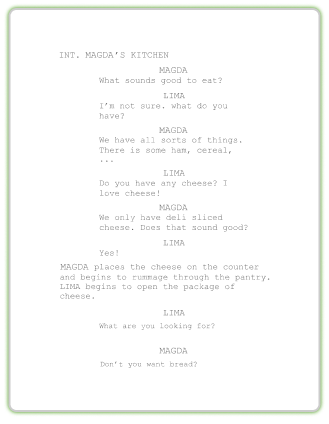With one click
Export a perfectly formatted traditional script.
Any writer can tell you that traditional screenwriting is a unique form of writing. With its own rules, structure, standard format, and expectations, screenwriting can be hard to get the hang of initially. One feature unique to screenwriting is scene headings, otherwise known as slug lines. They announce the setting of a scene. Do scene headings have any other uses? Can a slug line be used for descriptions other than the standard DAY and NIGHT? Keep reading to learn all about slug lines!
Export a perfectly formatted traditional script.


A scene heading is a short line of text in a screenplay that introduces a new setting in a scene. It includes three distinct parts within its master heading, including whether the location is inside or outside, where the scene takes place, and the time of day. This serves a couple of purposes: 1) to help the reader visualize the scene, and 2) to help someone reading a spec script get a better idea of budget based on the time of day and location of each scene. For example, it's much more expensive to shoot at night.
This is how you format scene headings or sluglines in a movie or television script.
Slug lines are all uppercase letters and best when left brief. They usually operate in one of two ways, as a master heading or as a subheading.
A master heading is the predominant job of the slug line. This type of heading starts the scene and alerts the reader to whether it's indoors (INT.) or outdoors (EXT.), the primary location, and the time of day. Be straightforward in your labeling of the location, don't offer up unnecessary details. As for the time of day, you can be as specific as is relevant to the story, so feel free to use day, night, dawn, dusk, morning, afternoon, etc.
Once the master heading is established, a writer might use a subheading or secondary scene heading to alert the reader to specific details with the master scene heading without creating a separate scene. This secondary heading might note a change in location within a larger single location.
You'll often see subheadings used when characters move to another room in a house. An example of this would be:
Carl searches his messy room for something. He digs under a pile of clothes. He pulls out an empty coffee mug, victorious.
Carl hurries into the kitchen, mug in hand, and makes a beeline for the coffeemaker. Just as he turns it on, the power goes out. Carl lets out a yell, stomping towards the basement door.
A subheading can also show the passage of time from the previous scene if the master location remains the same. As seen here:
Carl searches his messy room for something. He digs under a pile of clothes. He pulls out an empty coffee mug, victorious.
Carl hurries into the kitchen, mug in hand, and makes a beeline for the coffeemaker. Just as he turns it on, the power goes out. Carl lets out a yell, stomping towards the basement door.
A disheveled Carl returns to the kitchen. He looks like he's been through some sort of battle. He goes to the coffee maker and presses the button. It starts brewing. His shoulders sag in relief.
Subheadings can even signal a type of shot or draw focus to a specific character within a master scene. For example:
Carl searches his messy room for something. He digs under a pile of clothes. He pulls out an empty coffee mug, victorious.
Carl hurries into the kitchen, mug in hand, and makes a beeline for the coffeemaker. Just as he turns it on, the power goes out. Carl lets out a yell, stomping towards the basement door.
A disheveled Carl returns to the kitchen. He looks like he's been through some sort of battle. He goes to the coffee maker and presses the button. It starts brewing. His shoulders sag in relief.
Just as the machine gurgles coffee into his mug- BANG!
A large golden retriever rushes in, knocking over a kitchen chair. Startled, Carl flails, knocking the mug to the ground.
His eyes widen in fear. He screams a silent slow-motion NO.
Note: regardless of what the subheading is doing, they should all receive the same formatting, written on their own line in all caps.
My example wasn't particularly artful, so to see master headings and subheadings in action, check out the pilot script for NBC's Hannibal. The first few pages are full of subheading examples with proper traditional screenplay format.
Now you know all about sluglines! From master headings to subheadings, they're particularly helpful for immediately informing the reader of important information. If this is new to you, give different subheadings a try sometime! Happy writing!